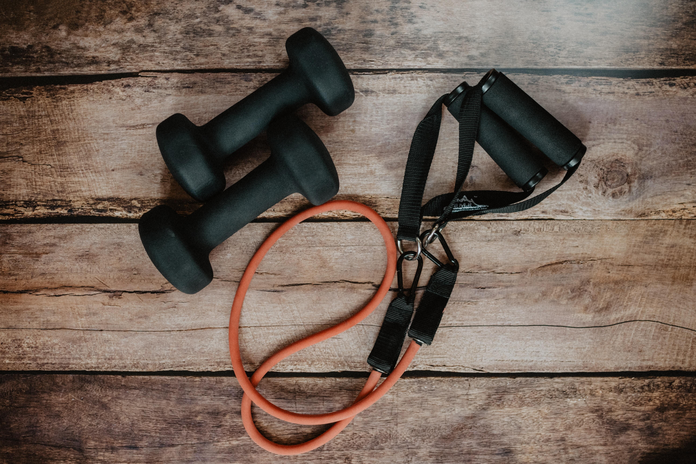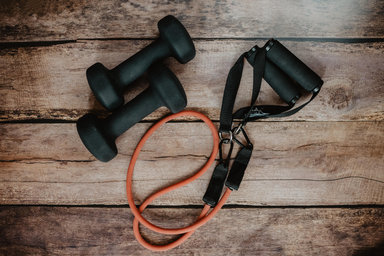This past year, I have fallen in love with weight training.
Weight training has been the most effective way for me to gain muscle, feel confident, and develop healthy habits. I like dedicating time to myself, I like blasting my music to near unbearable levels, and I like feeling as though I have forgotten how to walk or lift my coffee mug when I’m sore the next day. In a world as plugged-in as ours, working out is an easy way to hold our physical selves accountable, to challenge our bodies and see what we’re capable of.
So, naturally, when COVID hit, I thought the gyms closing would be my undoing. But I told myself I would try to find ways to make home workouts enjoyable and constructive to my fitness goals. Now, a year later, I feel as though I’m able to push myself just as hard as I used to at the gym.
Firstly, I am in no way a certified expert. I’m just an average person with some basic equipment at home: a light and heavy pair of dumbbells, a surface I can use as a bench, and resistance bands. Given those fairly limited resources, I have had to research and reimagine my home workouts. Here are the main things I have found that consistently help me gain muscle:
- Prioritize your protein intake
-
For a long time, I wasn’t seeing much muscle growth from my workouts. I struggled with how to best nourish my body to see real progress. Regardless of whatever else I decide to eat in a day, I now make sure that I am consuming enough protein to help my body recover from training as well as build and repair muscle. On top of improving muscle and bone health, protein also keeps you full longer, boosts the metabolism, and lowers blood pressure.
There is competing research about how much protein an active person should be consuming on a daily basis to grow muscle. Most sources indicate protein intake should fall between 0.5 to 0.8 times your body weight in pounds. For someone weighing 130 pounds, this would mean a range of 65 to 104 grams of protein consumed daily. An easy way to do this, without having to count anything or be restrictive, is simply to prioritize your protein content when meal planning. I do this by incorporating tofu, legumes like beans or lentils, and adding protein powder in smoothies. Remember that your body is a machine — performing mental and physical tasks all day — so it’s vital to make sure you’re fueling it appropriately.
- Start with activation exercises
-
Apart from stretching or a short bout of cardio to kick off your workout, try also performing muscle activation exercises. These are usually done with body weight or light resistance bands to “wake up” your target muscle. Activation is designed to establish a mind-to-muscle connection so that you really feel the stubborn muscle you’re trying to hit with your workout. It can be the difference between seeing muscle growth in your thighs when you want to be seeing it in your booty. I usually find it difficult to feel an exercise in my butt muscles if I don’t activate them first. Using a resistance band for glute activation exercises, like banded glute kickbacks or banded side-to-side squats, really helps me feel an exercise that I otherwise wouldn’t feel in its intended muscle.
Another mind-to-muscle trick that works for me is something I do during my actual workout. It sounds silly but sometimes just poking the muscle you’re targeting — like your shoulder, tricep, or glute — while you’re doing a repetition can remind you of where you should be engaging or squeezing.
Activation is often very individualized, depending on which muscles you’re training, and what feels like it’s working most for you. So, look into different activation exercises and see what fits best!
- Use progressive overload
-
If you’re trying to grow muscle — whether this be to tone up, to recover from an injury, or to just feel stronger — the most efficient solution is to weight train.
“Progressive overload” can be an intimidating term, but what it means is gradually putting more and more stress on a muscle over time. The key with progressive overload is to always be in a place where your workout feels challenging for you. In at-home weight training, there are several ways to go about this, such as increasing the weight you’re using or doing a higher number of repetitions of an exercise over time. If you can lift a seven-pound weight fairly easily, for example, try doing more repetitions or using a slightly heavier weight.
First and foremost, ensure that the weight you pick as a starting point is one you can comfortably handle while maintaining proper form. It’s safer and more effective to pick a lighter weight if it means you can fully concentrate on your technique. Sacrificing form to lift heavier might make other muscles kick in to compensate, or even lead to injury.
- Be consistent, be patient
-
Patience has historically not been my greatest virtue when it comes to working out. It can be frustrating not to see fantastic results right away, or even after a few months of training. Try to recognize the bigger picture, and remind yourself of why you’re working out in the first place. Often, results will come in more ways than just the physical, and you’ll begin to feel better as a whole just by putting in the effort. All you need is patience.
- Muscle to Mind
-
As students, we spend most of our time focused on cerebral tasks that involve us sitting in front of a computer — reading thirty-page articles or watching lectures at double speed. So, I understand how it might seem strange to put time aside to engage in physical activity when it could be spent working or studying.
Working out can also feel tough and pointless if you’re doing it for the wrong reasons. I never used to be mindful about what working out could do for me if I more actively participated in my workouts. It took a long time for me to reap the benefits. I soon realized I’d been working out just to say I had, rather than to truly push myself. But now? I have developed an organized routine custom to me and my needs that allows me to take time to unwind. From working out, I now have a better connection to my body and what it needs. I give myself days every week for rest and recovery. I have an improved relationship with food and a better grasp on how to fuel my body. And, my self-love and confidence have gone through the roof.
The whole point of exercising is to find an activity that feels reasonable for you and gets your blood pumping. You might try weight training after this and realize it’s not for you at all. Just find something that gets you excited to move your body, and you’ll be shocked at how many other parts of your life it changes.



